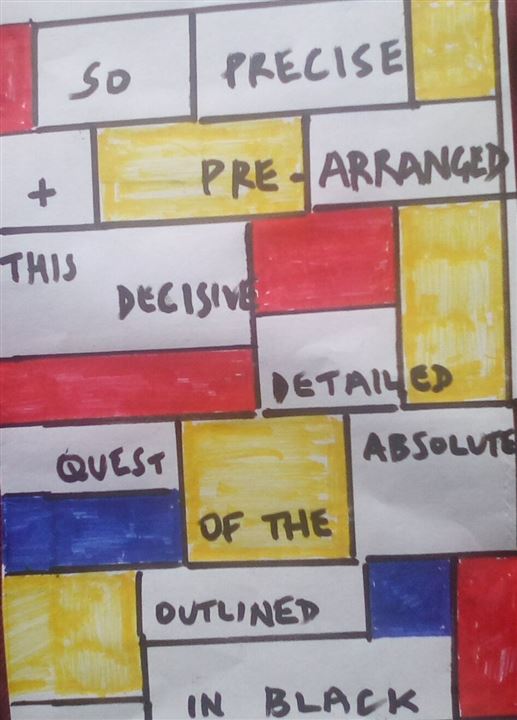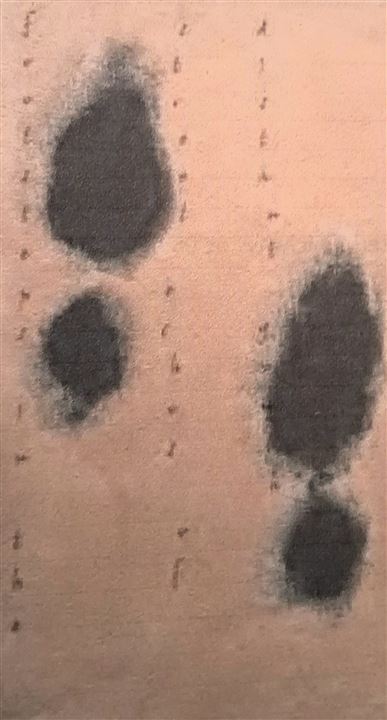Often
Kindnesses float
Like petals on a stream;
A fragrance that lingers within
The heart
Drift,rising with
Brown buzzard ground circling
Silhouette shadowed before
Slaying
Darkness
Descending slow
Breaking out of the silence
Of the winter's night,a single
Owl screech
Hunger
Which haunts each dark
Hour,as coldness kills,thus
Does Nature's chain perpetuate
At night.
hiku- the untitled tristich free-verse- version of haiku-in- english the difference being it has has no syllabic constraints and may contain digititised shapes within its triplicity.
It is spelt differently than the centuries old Japanese traditional phonetical & cultural poetic form to respect the 'haiku' unique traditions & to thereby differeniate but remains a present tense poetic the written or recited equivalent to arts 'gestural spontaneous happening' in a triplicity form.
hiku=haiku-in-english Doubled= 2 separate stand-alone untitled hiku - capable of unifying into a six-liner
momentarily
wait hesitate and dream-
imagination cries
unshackled
conception awakens-
formulates
ORIGINS
There once lived a friar,Thomas of Aquino
in latin,did his poetry flow
In a prayer anapestic
this form was to stick
until Lear gave AABBA ,a go
The Clerihew poem came about in the 1927 and is named after Edmund Clerihew Bentley (1875–1956), the English writer who invented it. The Clerihew is a biography that makes fun of a famous person.It tends to show the subject of the poem from an unusual point of view. It usually has 4 lines of irregular length and is metered for a comical effect.
The rhyming structure of the Clerihew poem is AABB, with phrases that can be in Latin, French and other non-English languages. The end of the first line of a true Clerihew poem will only consist of the subjects name
Edmund Clerihew Bentley wrote poetry everso gently. His greatest claim to fame immortalised his mother's maiden name
OPEN VERSE may be described as an apperception of poetic elements -
imagery,assonance,rhythm,sound symbolism of an intuitive of the self conscious in a crystallised convergence of the moment ,with punctuation implied by the form,
interpretation by the reader changing according to mood, thus essentially fluid and inherently variable.Especially in poetry read aloud where interpretation is unique each time as the reader participates in the poem as one does when iviewing a painting in a gallery
I first wrote in this style in Jan 2012..@PS... it is AN OPEN (organic) 1 VERSE using spaces&breaks without grammatical symbols ,the ' open' relies upon 'the one breath limitation' (intuitive cadence)& so inherently requires the 'reader' (reciter) to input and responds thus making this enigmatic form a two way interplay & interpretatIon unique to the moment
An example & recitation 1 to explain
Will my verse reach your ear can your eye stay the course Does unconvention confound the rhythm of your eyes Take a deep breath exhale and read between my lines unphased by phrase and habitude or human voice The choice is always yours if my poem will be or is not to be a tune upon your ear explain
NOTE 1 https://m.youtube.com/watch?v=iEuqldQdLb8
2.My open verse is organic in some interpretative aspects similar but different from that of
Hilda Morley created (in the 1970's ) this type of this 'verse freed' (which she labelled 'organic' )ie freed from convention,formal in experimentation closely related to Denise Levertov definition "organic form in poetry'. An early organic Sea Lily https://m.youtube.com/watch?v=G7T7t3zuVMc
ALLITERATION an ancient form that relies upon sounds to alert the ear & hold attention when recited.
Connections Confront,clash,collide COMBAT !
Cold shoulder,chill,cool CUT-OFF !
Cry,crave,collect CALL-ON !
Constant,compassion,consider CHARITY !
Confer,commune,converse COMMUNICATE !
Convene,concert,consensus CONCORD !
COVENANT ! CHRIST ! CHURCH
QUATRAIN the basic poetic & most ancient form with many many forms thereof here is one example an englyn
Her love was like a rose,
with no perfume.
Dressed in very fine clothes passion she could not propose,
brought the romance to a close.
TANKA in english ( from the Japanese form) a 20th century 5 line form split as a tristich & couplet
BONFIRE NIGHT LINE 1. november the fifth- } 2. layered rolls of liquid fog } S H O W 3. envelope the bonfire- } 4. the party becomes a } T E L L 5. damp squib }
SHAPE
a literary piece of wordplay the succeeds in combining in a hybrid fusion of two artforms ...art & poetry originates from 300BC
HAIGA is a Japanese shape form a hybrid fusion of art & poetry
TRISTICH Parallel untitled- L1 theme L2 echo of theme L3 punchline/observation
example
tears begin to fall
emotion becomes a flood-
a cataract of regret flows
EKPHRASIS found as far back as 800BC (in many forms) describes poetically art,music in all its aspects
SURREALITY
an image blue a memory fleeting midst black,white & colour flows shadows stream & ideas fly free to drift afterthoughts floating zig-zags primitive themes the unconscious pre occupied the misshapen in designs to surprise & provoke glimpses into the bizarre a short breath blown a frottage of connections embryonic& diffused imprecise concisely conceived
EMAGI
The art of creating a visual response to a piece of writing is known as a reverse ekphrasis ie the inverse of the centuries old poetic form of ekphrasis.The most well known example being Charles Demuth 'Figure 5' based upon a W C Williams poem. EMAGI is my recent variation of a reverse ekphrasis derived by the advent of the widespread use of hand held digital communication devices -where words in digital symbols /letters can be represented as a shape and uses a poet's poem to inspire the digitised 'drawing'
FIBONACCI a 20th century form based on Leonardo Fibonacci, who in 1202 developed this mathematical basis thereof
Verse Freed To Fibonacci
IMAGISM a early 1900's challenge to conventional poetics that freed verse , was developed from French symbolist poetics
the use clear, simple language to paint a picture. Imagery, on the other hand, is use of flowery and descriptive language, and often figurative language, to create an image in the reader’s mind. An imagist would keep things simple, and not use imagery other than specific sensory details.
https://imageverse.blogspot.com/
FREED VERSE
a creative- written & verbal art evolved naturally during the past century commencing with the Imagists in the early 1900's who 'freed up' traditional poetic thinking, along with the English language translators of Japanese haiku forms who thereby stimulated the interest & innovations in English short form poetics.
Recited rhymes,commonly known by all, was stimulated into wider-spread interest in all poetry by the invention of the typewriter,soon followed by digital devices linked to the internet faciltated the process whereby poetry became a more common art practised daily by hundreds of thousands worldwide.The poetry sites like PS in the early 21st century continued & widened the evolution of 'freed form' poetry.
Other Educational Poetry Blogs of mine are
to be found by clicking my profile


